
Sleep architecture is the basic pattern of normal sleep. There are two main types of sleep. Non-rapid eye movement (NREM) and rapid eye movement (REM). NREM has three different stages, all of which have a different depth of sleep. They are identified by sleep experts through brain-wave patterns, eye movements and muscle tone.
REM sleep is a stage all by itself and is the stage of "dreaming". This can be identified through higher levels of brain wave activity and being as close to being awake as possible. Continue reading to find out more about what sleep architecture is and associated conditions when it is disrupted.
Structure
Sleep architecture can allow experts to create a picture of what your sleep looks like over the course of a night. They look at the various depths of sleep and what you look like when you come out of sleep.
It is represented by a graph called a hypnogram, which is created with the use of an EEG.
A normal sleep architecture consists of four or five different sleep cycles during a given night. Each cycle lasts between 90 minutes and two hours. Some will contain all three stages of NREM sleep plus the REM. However, not all of them will.
NREM Stage 1
This is the stage where you've just drifted off to sleep. You are not consciously aware of your surroundings, but it's easy to wake you. If you are awake, you may not even realize you've fallen asleep. This can be observed by the following physical changes:
- relaxed muscles
- dropped body temperature
- slow side to side eye movements
- brain waves transition from rhythmic alpha to mixed-frequency theta waves
This stage normally lasts 5-10 minutes. You may return to it throughout the night, but it is not included in each cycle. The amount of time spent in this stage increases with age which can make it harder to fall and stay asleep.
NREM Stage 2 Sleep
Once you're fully asleep, you enter NREM stage 2. It is more difficult to awaken you in this stage, but there still is a certain amount of vigilance. If someone makes a loud noise or whispers, there is still a response. The physical changes of this stage include:
- lack of eye movement
- continued drop in body temperature
- regular breathing and heart rate
- rapid bursts of brain activity - which may indicate organization and memory storage from the brain.
This phase gets progressively longer with each cycle, and it's common to spend about half the night in this phase. It can alternate with REM for much of the night without NREM 3 in between.
NREM Stage 3 Sleep
This is also called deep sleep or slow-wave sleep. This is when it is hardest to be awakened. This phase is believed to be essential for restorative sleep which is when your body repairs itself and allows you to feel awake and refresh. It is also important for memory and creativity. Changes for this stage of sleep can be:
- increased relaxation
- decreased pulse and breathing rate
- less blood flow to the brain
- release of growth hormone
- increase immune-system activation
- slow brain waves called delta waves
This stage is more frequent early in the night when it can last for up to 40 minutes. Throughout the night, it gets shorter as REM phases get longer. It also may not even be a part of some cycles. You don't progress directly from NREM3 to REM. It's normal to go back to NREM2 and them progress to REM.
REM Sleep
REM is the deepest state of sleep and is when you dream. Experts believe this is the stage of sleep when brain is restored and prepared for the next day. This phase is characterized by:
- muscle immobility
- increased breathing rate, heart rate, and blood pressure
- increased body temperature
- bursts of rapid eye movements
- increased brain activity
- theta and slow alpha brain waves
Consistent interruptions of this phase can lead to many issues,such as sleep paralysis, and trouble with forming new memories.
You can enter REM sleep anywhere from 3-5 times a night, about every 90 minutes. These phases are longer and more frequent throughout the night, eventually lasting around 30 minutes.
Influencing Factors
Although sleep architecture can be typical, these patterns very greatly from person to person, and within the same person over time. Sleep architecture can be influenced by:
- age
- sex
- the time of day asleep
- how much time is allocated to sleep
- use of caffeine, nicotine, alcohol, marijuana or drugs
- sleep disorders
Associated Conditions
Some sleep disorders and other illnesses involve abnormal sleep architecture, while others can cause disruptions to sleep architecture.
- Insomnia
- Narcolepsy
- Sleep apnea
- Depression
- Schizophrenia
Leaving disordered sleep architecture unattended to can lead to cognitive dysfunction and other health problems. Sleep deprivation, and just being tired, negatively impacts life, which will be the outcome with addressing a disordered sleep architecture.
Addressing these issues requires some sort of sleep study, or a polysomnogram. This includes spending the night in a facility and being hooked up to several wires and probes that measure various vitals and brain waves throughout the night. The results are read by a sleep specialists for a diagnosis.
If the sleep study is inconclusive, then your healthcare provider may ask you to keep track of your sleeping hours by evaluating your daytime sleepiness and other symptoms. You may also be sent lab tests to check for other possible causes of symptoms.
Treatment is dependent on the cause of your issues. If you think you are having trouble sleeping, and think the cause may be an abnormal sleep structure, then please click the orange button below to take a free online sleep test. Then, you can contact one of our sleep health experts to proceed.
https://www.verywellhealth.com/what-is-sleep-architecture-3014823

